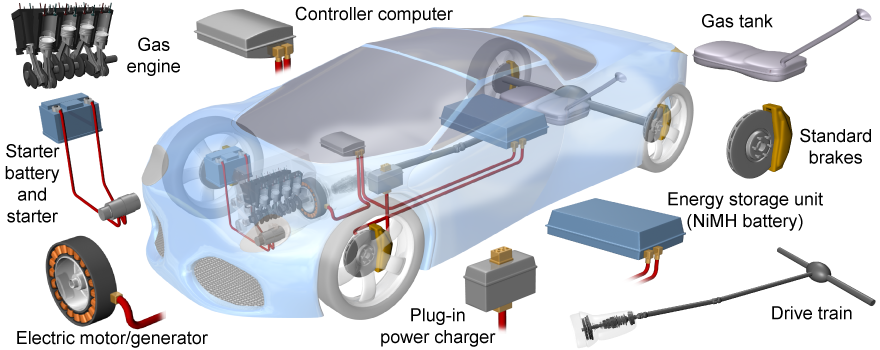|

|
Although the first widely available hybrid was commercially produced beginning in 1997, working prototypes existed as early 1900! A hybrid electric vehicle is a car that has both a gas engine and an electric motor. It is therefore powered both by gasoline and by electricity stored in a battery. 
|
At the heart of a hybrid (or electric!) car lies an electric motor that transforms electrical energy from a battery into rotational motion of the drive shaft. As you learned on page 551, the electric motor is based on the link between electricity and magnetism. 
|
Hybrid cars have a standard gas engine under their hoods, but the engines are typically small and would be considered underpowered if they were the sole power source for the car. (Fully electric cars, in contrast, have no gas engine at all!) 
|
All cars, including hybrid cars, have a car battery under the hood that is used to start the engine. But a hybrid car also contains a large number of nickel metal hydride (NiMH) batteries—usually located underneath the rear seats or trunk—that are dedicated to powering its electric motor. 
|
One major difference with the hybrid cars of a century ago is that today’s hybrid cars usually contain a generator for recharging the battery. When the gas engine is running, but delivers more power than needed to move the car, the excess power is used to drive the generator. The generator is also used during regenerative braking. 
|
When braking, modern hybrid and electric cars transform some of their kinetic energy into electrical energy using regenerative braking, which you learned about at the beginning of the chapter. The regenerative braking system in hybrid cars is in addition to the standard brakes—using friction on brake pads—that all cars have. 
|
With improved batteries, the electric storage capacity of some hybrid cars has been increased to the point that the car could operate on the electric motor alone for a few or a few dozen miles. It is more efficient to recharge these high-capacity batteries between trips using a power outlet, which is why some hybrid cars are called “plug-in hybrids.” 
|
One model of hybrid car has a gas engine with a power of 57 kW and an electric motor with a power of 50 kW. What are these values in horsepower?
 |
One horsepower (hp) is equivalent to 746 W. Converting the gas engine power to horsepower gives and converting the electric motor power to horsepower gives 
|

